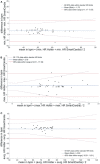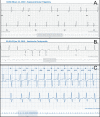Cardiac Ambulatory Monitoring: New Wireless Device Validated Against Conventional Holter Monitoring in a Case Series
- PMID: 33330650
- PMCID: PMC7733961
- DOI: 10.3389/fcvm.2020.587945
Cardiac Ambulatory Monitoring: New Wireless Device Validated Against Conventional Holter Monitoring in a Case Series
Abstract
Background: Cardiac arrhythmias are very common but underdiagnosed due to their transient and asymptomatic nature. An optimization of arrhythmia detection would permit to better treat patients and could substantially reduce morbidity and mortality. The SmartCardia ScaAI wireless patch is a novel CE IIa approved, single-lead electrocardiographic (ECG) ambulatory monitor designed for cardiac arrhythmias detection. Hypothesis: The accuracy of the new SmartCardia wireless patch to detect arrhythmias is comparable to the conventional Holter monitoring. Methods: Patients referred for a suspicion of arrhythmia between February and March 2020 were included in the trial. Simultaneous ambulatory ECG were recorded using a conventional 24-h Holter and the SmartCardia. The primary endpoint was the detection of cardiac arrhythmias over the total wear time of the devices, defined as premature atrial contraction (PAC), supraventricular tachycardia ≥3 beats, premature ventricular contraction (PVC), and ventricular tachycardia ≥3 beats. Conduction abnormalities, pause ≥2 s and atrioventricular block (AVB), were also tracked. McNemar's test was used to compare the matched pairs of data from both devices. Results: A total of 40 patients were included in the trial. Over the total wear time, there was no significant difference between the devices for ventricular and supraventricular arrhythmias detection. Pauses and AVB were equally identified by the two devices in three patients. Conclusion: Over the total wear time, the SmartCardia device showed an accuracy to detect arrhythmia similar to the 24-h Holter monitoring: single-lead, adhesive-patch monitoring might become an interesting alternative to the conventional Holter monitoring.
Keywords: Holter monitoring; SmartCardia patch; atrial fibrillation; cardiac arrhythmias; electrocardiogram; wireless recorder.
Copyright © 2020 Murali, Brugger, Rincon, Mashru, Cook and Goy.
Conflict of interest statement
SM, FR, and MM are members of the board of SmartCardia. The remaining authors declare that the research was conducted in the absence of any commercial or financial relationships that could be construed as a potential conflict of interest.
Figures




References
LinkOut - more resources
Full Text Sources
Other Literature Sources

